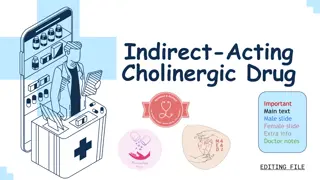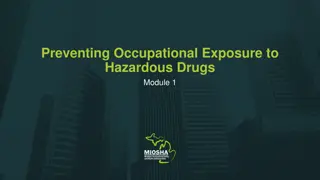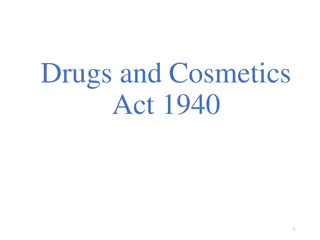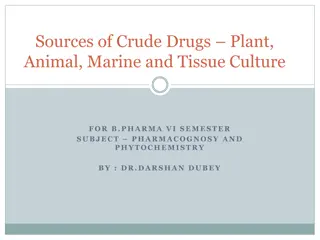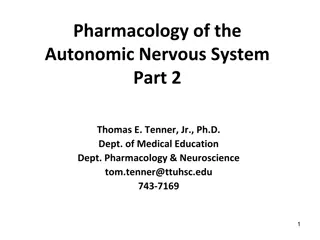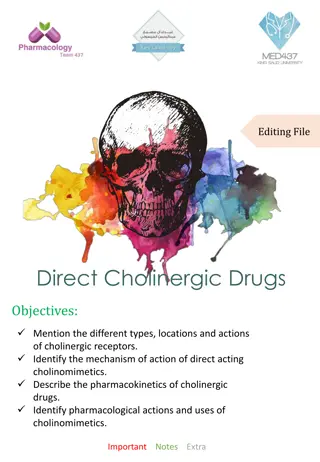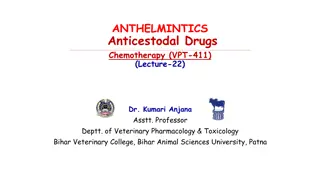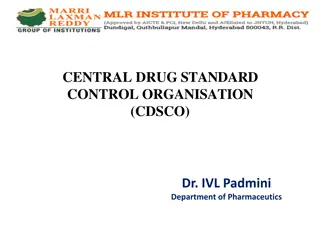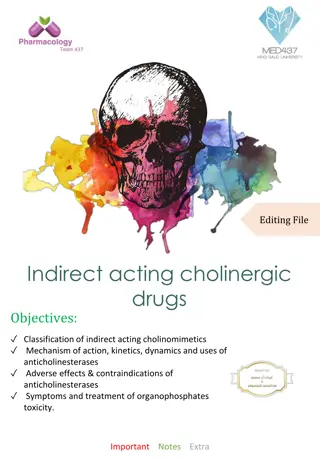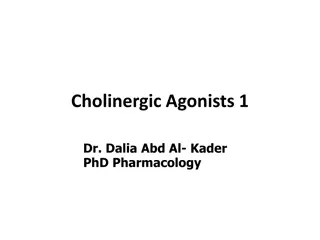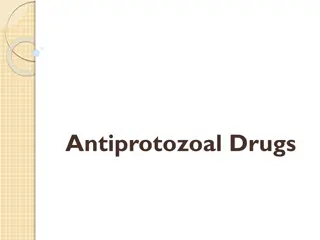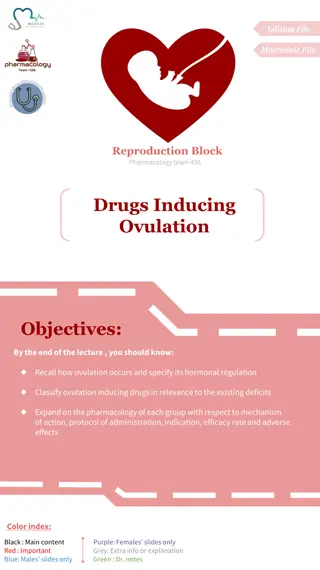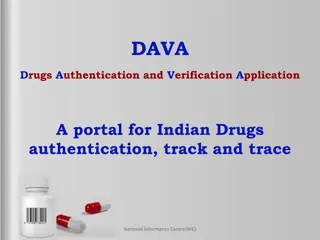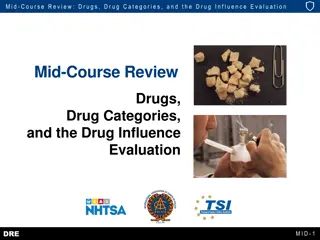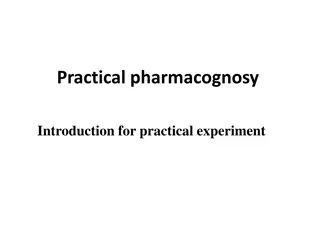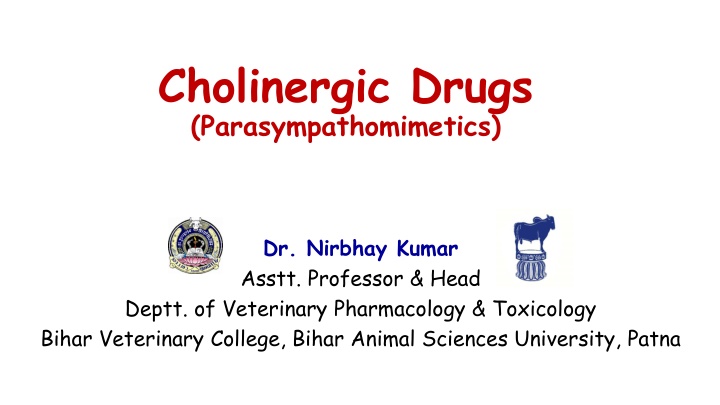
Cholinergic Drugs and Their Classification in Veterinary Pharmacology
Cholinergic drugs, also known as parasympathomimetics, mimic the effects of parasympathetic post-ganglionic nerves or acetylcholine in veterinary pharmacology. This article explores the classification of cholinergic drugs, including choline esters like acetylcholine, methacholine, carbachol, and bethanechol. Discover the properties and selective actions of choline esters in veterinary medicine.
Download Presentation

Please find below an Image/Link to download the presentation.
The content on the website is provided AS IS for your information and personal use only. It may not be sold, licensed, or shared on other websites without obtaining consent from the author. If you encounter any issues during the download, it is possible that the publisher has removed the file from their server.
You are allowed to download the files provided on this website for personal or commercial use, subject to the condition that they are used lawfully. All files are the property of their respective owners.
The content on the website is provided AS IS for your information and personal use only. It may not be sold, licensed, or shared on other websites without obtaining consent from the author.
E N D
Presentation Transcript
Cholinergic Drugs (Parasympathomimetics) Dr. Nirbhay Kumar Asstt. Professor & Head Deptt. of Veterinary Pharmacology & Toxicology Bihar Veterinary College, Bihar Animal Sciences University, Patna
Cholinergic (Parasympathomimetic) Drugs Drugs which mimic the effects of parasympathetic post-ganglionic nerves or those of acetylcholine. Also called as cholinergics, cholinergic agonists or cholinomimetics. These have agonistic action on cholinergic receptors at autonomic ganglia, neuromuscular junction etc.
I. Choline Esters 1. Acetylcholine (ACh): Although is essential for maintenance of body homeostasis, it is not used therapeutically for two important reasons: It acts simultaneously at various tissue sites and no selective therapeutic response can be achieved. Its duration of action is quite brief because it is rapidly inactivated by the cholinesterases.
I. Choline Esters continued 2. Methacholine (Acetyl- -methylcholine): Synthetic choline ester used occasionally in human therapeutics but infrequently (rarely) employed in veterinary medicine. Methacholine causes muscarinic effects on cardiovascular function similar to those produced by ACh, but it is considerably less active on GI system. Methacholine lacks nicotinic action. Methacholine is a cholinomimetic of choice for controlling tachycardias of atrial origin. It will cause slowing of heart, reduction of the force of contraction & generalized vasodilatation. Main site of action of methacholine is the pacemaker.
I. Choline Esters continued 3. Carbachol (Carbamoylcholine): Extremely potent choline ester active at both muscarinic and nicotinic receptors. Carbachol is sometimes used for the emergency treatment of colic in the horse and ruminal stasis in cattle. Administration of carbachol is done with great care and the drug is given in repeated small doses of 1-2 mg subcutaneously. 4. Bethanechol (Carbamoylmethylcholine): It is somewhat similar to methacholine and carbachol, however it is primarily a muscarinic agonist, and has little stimulant effects on nicotinic receptors.
I. Choline Esters continued Table:Showing properties of choline esters Hydrolyzed by Actions Choline esters Selective actions on AChE BuChE Muscarinic Nicotinic ACh ++ + + + Non-selective Methacholine + + CVS Carbachol + + GIT, Bladder Bethanechol + GIT, Bladder
I. Choline Esters continued Therapeutic uses of choline esters (i) Methacholine and bethanechol are not used frequently in clinical veterinary medicine. Methacholine has been used in human medicine to control tachycardia of supraventricular origin. (ii) Bethanechol, 1 mg administered subcutaneously b.i.d. has been used to treat urinary bladder atony in cats after incidence of urolithiasis. (iii) Carbachol has been used in the treatment of colic and impactions of the intestinal tract. It is also used in the treatment of ruminal atony and impaction in cattle.
II. Natural Alkaloids 1. Pilocarpine: Obtained from the leaves of Brazilian shrubs Pilocarpus jaborandi and P. microphyllus. Prominent muscarinic actions. Stimulates flow of secretions from exocrine glands, including salivary, mucous, gastric & digestive pancreatic secretions. Causes contraction of GI smooth muscle & increases smooth muscle tone and peristaltic activity. Has a potent constrictor effect on the pupil. Penetrates cornea and promptly causes miosis, ciliary muscle contraction and fall in intraocular tension lasting 4-8 hours.
II. Natural Alkaloids continued 2. Arecholine: An alkaloid found in the beetle nut, the seed of the beetle palm (Areca catechu). Has muscarinic as well as nicotinic actions including those on skeletal muscle end plate. Is similar to Pilocarpine in scope of activity but is considerably more potent. It stimulates secretion of the glands of the digestive tract and increases peristaltic movement of the gut. Increased flow of the saliva occurring within 5 minutes following a subcutaneous injection and lasting for an hour is particularly noticeable. Arecholine contracts the urinary bladder.
II. Natural Alkaloids continued 2. Muscarine: Found in the poisonous mushrooms Amanita muscaria, and has only muscarinic actions. It is not used therapeutically, but, is of toxicological importance.
II. Natural Alkaloids continued Therapeutic uses of Cholinomimetic Natural Alkaloids: Clinically, solutions of 0.5 to 2% of pilocarpine are used for instillation into the conjunctival sac for treatment of glaucoma. Other uses of pilocarpine as a miotic are to counteract mydriatics after they have been used for testing refraction and to prevent or break adhesions of iris with lens or cornea by alternating it with mydriatics.
III. Cholinesterase Inhibitors These are indirect acting parasympathomimetic agents. They inactivate or inhibit AChE and pseudoChE and thereby intensify the activity of endogenous ACh. Acetylcholinesterase (AChE): Anionic site: Active region of AChE formed by tryptophan Esteratic site: Formed by serine, glutamate and histidine
III. Cholinesterase Inhibitors continued Hydrolysis of ACh by AChE: Involves attraction of +ly charged N+ of ACh to the aromatic pocket and attack by serine OH which is activated by the adjacent histidine acetylation of the serine. The acetylated reacts with produce acetic acid and choline. The reaction is very fast. electrostatic nucleophilic leading to enzyme water to
III. Cholinesterase Inhibitors continued [A]. Reversible Cholinesterase Inhibitors: Mechanism of action: These agents reversibly bind to the active sites of the enzyme, as they serve as alternate substrates for AChE. Edrophonium and Tacrine attach only to the anionic site of the enzyme and tacrine inhibited enzyme does not involve hydrolysis of the inhibitor, but only its diffusion so action is brief. Physostigmine and Neostigmine bind to both anionic and esteratic sites of the enzyme. So, the carbamylation of the enzyme (with neostigmine and physostigmine) is of longer duration than the inhibition by edrophonium. Thus, during the period where the enzyme inhibitor complex exists, the enzyme will not hydrolyze its natural substrate ACh.
III. Cholinesterase Inhibitors continued [A]. Reversible Cholinesterase Inhibitors: 1. Physostigmine: An alkaloid extracted from the dried ripe seeds of a vine, Physostigma venenosum which grows in tropical West Africa. It is also known as Calabar bean or Ordeal bean . Now-a-days, physostigmine is used for its ability to constrict the pupil or as miotic and in the treatment of deadly nightshade poisoning. 2. Neostigmine: It is the salt of a synthetically produced substance structurally related to physostigmine. It is used as purgative and in the treatment of atony of urinary bladder.
III. Cholinesterase Inhibitors continued Comparative features of Physostigmine and Neostigmine: Physostigmine Calabar bean Tertiary amine derivative Good Present Penetrates cornea Absent Neostigmine Synthetic 1. Source 2. Chemistry 3. Oral absorption 4. CNS actions 5. Applied to eye 6. Direct action on cholinoceptors 7. Prominent effect on 8. Important use 9. Dose Quaternary ammonium compound Poor Absent Poor penetration Present Autonomic effectors Miotic (in glaucoma) 0.5 1 mg (man) oral or parenteral 0.1 1% in eye drops. Systemic - 4 to 6 hours Eye 6 to 24 hours Skeletal muscle Myasthenia gravis 0.5 2.5 mg (man) i.m./ s.c 10.Duration of action 4 to 6 hours.
III. Cholinesterase Inhibitors continued [B]. Irreversible Cholinesterase Inhibitors: Mechanism of action: Organophosphates act as irreversible inhibitors of the cholinesterases in mammals. These compounds irreversibly phosphorylate the esteratic site of both AChE and the non-specific or the pseudocholinesterase throughout the body. Endogenous ACh is not inactivated and the resulting effects are due to the excessive preservation and accumulation of endogenous ACh.
III. Cholinesterase Inhibitors continued [B]. Irreversible Cholinesterase Inhibitors: Effects & Toxicity: Muscarinic effects: Profuse salivation, vomiting, defaecation, hypermotility of the GI tract, urination, bradycardia, hypotension, severe bronchoconstriction and excess bronchial secretions. Nicotinic effects: Skeletal muscle fasciculations, twitching and subsequently muscle paralysis. CNS symptoms: Convulsions and frequently death due to the penetration of the agents into the CNS and subsequent intensification of the activity of ACh at CNS sites.
III. Cholinesterase Inhibitors continued [B]. Irreversible Cholinesterase Inhibitors: Treatment of organophosphate poisoning: 1st line of treatment : Atropine to counter muscarinic effects of ACh @ 0.2 to 0.5 mg/kg b.wt. (maximum dose = 1 mg/kg). It is administered as 0.15% solution of atropine in physiological saline. 2nd line of treatment : Oxime reactivators viz. diacetyl monoxime (DAM), 2-pyridine aldoxime methiodide (2-PAM or pralidoxime), obidoxime etc. which reactivate the phosphorylated AChE enzyme and greatly accelerates clinical recovery. Ageing: The usefulness of oxime reactivators is limited to a short period (minutes or hours depending on the compound) because the enzyme phosphate complex becomes resistant when a further group is removed by hydrolysis, a change known as ageing .
III. Cholinesterase Inhibitors continued [B]. Irreversible Cholinesterase Inhibitors: Therapeutic Uses of Cholinesterase Inhibitors: The only drug indication is the relief of glaucoma where a single instillation of dyflos (di-isopropylfluorophosphate) or echothiopate acts for several weeks. Organophosphates and carbamates are used as insecticides for the control of insect vectors and ectoparasites.

